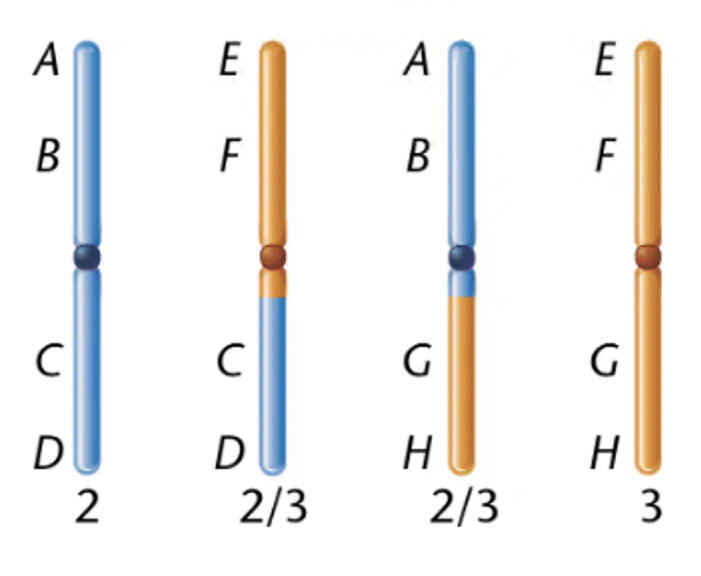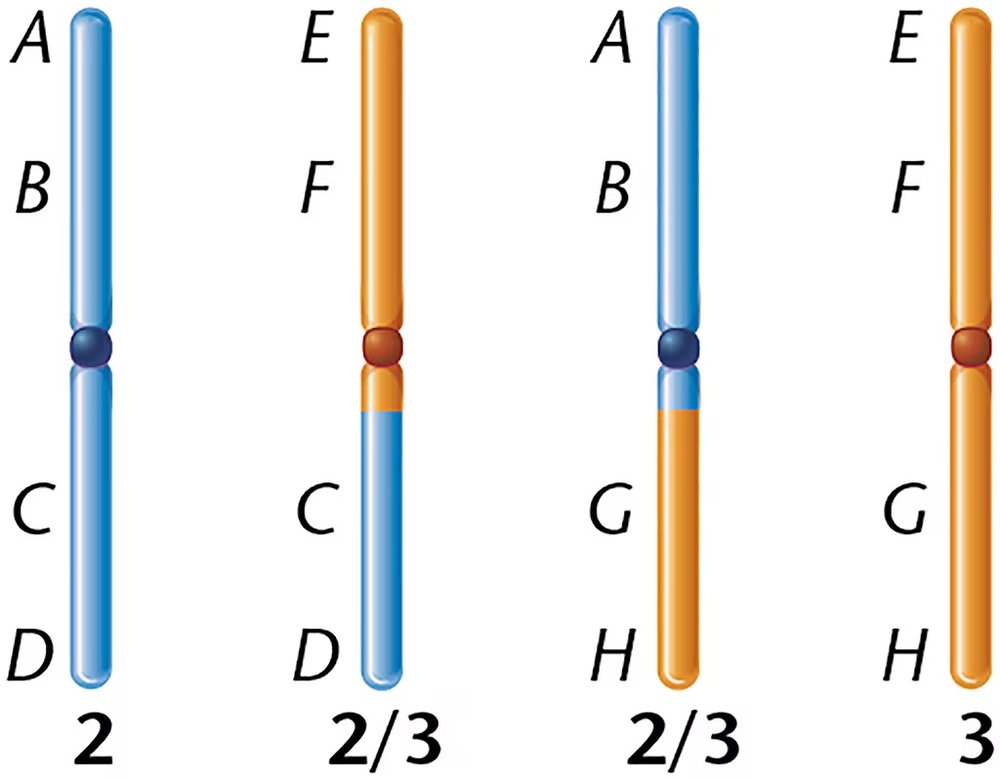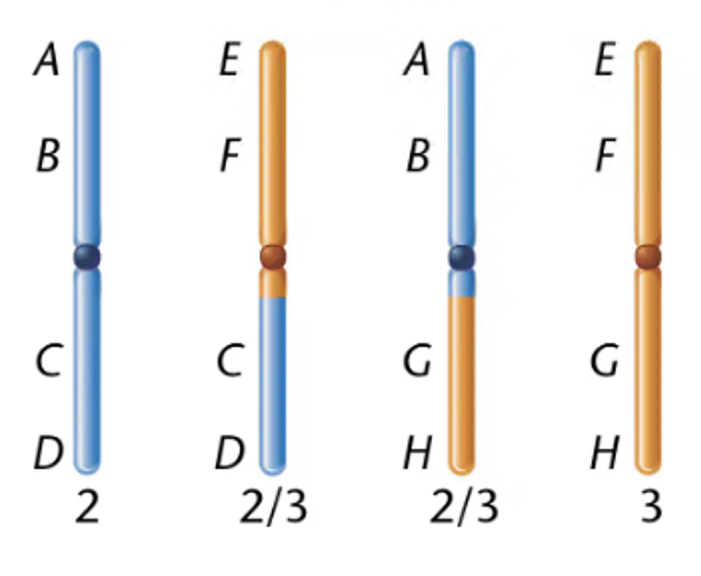 Back
BackProblem 1a
How do we know that the extra chromosome causing Down syndrome is usually maternal in origin?
Problem 1b
How do we know that human aneuploidy for each of the 22 autosomes occurs at conception, even though most often human aneuploids do not survive embryonic or fetal development and thus are never observed at birth?
Problem 1c
How do we know that specific mutant phenotypes are due to changes in chromosome number or structure?
Problem 1d
How do we know that the mutant Bar-eye phenotype in Drosophila is due to a duplicated gene region rather than to a change in the nucleotide sequence of a gene?
Problem 2
Write a short essay that discusses five altered phenotypes that result from specific chromosomal aberrations.
Problem 3
Define these pairs of terms, and distinguish between them.
aneuploidy/ euploidy
monosomy/ trisomy
Patau syndrome/ Edwards syndrome
autopolyploidy/ allopolyploidy
autotetraploid/ amphidiploid
paracentric inversion/ pericentric inversion
Problem 4
For a species with a diploid number of 18, indicate how many chromosomes will be present in the somatic nuclei of individuals that are haploid, tetraploid, trisomic, and monosomic.
Problem 5
What evidence suggests that Down syndrome is more often the result of nondisjunction during oogenesis rather than during spermatogenesis?
Problem 6
Contrast the fertility of an allotetraploid with an autotriploid and an autotetraploid.
Problem 7
Why do human monosomics most often fail to survive prenatal development?
Problem 8
Describe the origin of cultivated American cotton.
Problem 9
Predict how the synaptic configurations of homologous pairs of chromosomes might appear when one member is normal and the other member has sustained a deletion or duplication.
Problem 10
Inversions are said to 'suppress crossing over.' Is this terminology technically correct? If not, restate the description accurately.
Problem 11
Predict the genetic composition of gametes derived from tetrads of inversion heterozygotes where crossing over occurs within a pericentric inversion.
Problem 12
Human adult hemoglobin is a tetramer containing two alpha (α) and two beta (β) polypeptide chains. The α gene cluster on chromosome 16 and the β gene cluster on chromosome 11 share amino acid similarities such that 61 of the amino acids of the α-globin polypeptide (141 amino acids long) are shared in identical sequence with the β-globin polypeptide (146 amino acids long). How might one explain the existence of two polypeptides with partially shared function and structure on two different chromosomes?
Problem 13
The primrose, Primula kewensis, has 36 chromosomes that are similar in appearance to the chromosomes in two related species, P. floribunda (2n=18) and P. verticillata (2n=18). How could P. kewensis arise from these species? How would you describe P. kewensis in genetic terms?
Problem 14
Certain varieties of chrysanthemums contain 18, 36, 54, 72, and 90 chromosomes; all are multiples of a basic set of nine chromosomes. How would you describe these varieties genetically? What feature do the karyotypes of each variety share? A variety with 27 chromosomes has been discovered, but it is sterile. Why?
Problem 15a
Drosophila may be monosomic for chromosome 4, yet remain fertile. Contrast the F₁ and F₂ results of the following crosses involving the recessive chromosome 4 trait, bent bristles:
monosomic IV, bent bristles x diploid, normal bristles
Problem 15b
Drosophila may be monosomic for chromosome 4, yet remain fertile. Contrast the F₁ and F₂ results of the following crosses involving the recessive chromosome 4 trait, bent bristles:
monosomic IV, normal bristles x diploid, bent bristles.
Problem 16
Mendelian ratios are modified in crosses involving autotetraploids. Assume that one plant expresses the dominant trait green seeds and is homozygous (WWWW). This plant is crossed to one with white seeds that is also homozygous (wwww). If only one dominant allele is sufficient to produce green seeds, predict the F₁ and F₂ results of such a cross. Assume that synapsis between chromosome pairs is random during meiosis.
Problem 17
Having correctly established the F₂ ratio in Problem 18, predict the F₂ ratio of a 'dihybrid' cross involving two independently assorting characteristics (e.g., P₁ = WWWWAAAA x wwwwaaaa).
Problem 18
In a cross between two varieties of corn,
gl1gl1Ws3Ws3 (egg parent) × Gl1Gl1ws3ws3 (pollen parent), a triploid offspring was produced with the genetic constitution Gl1Gl1gl1Ws3ws3ws3. From which parent, egg or pollen, did the 2n gamete originate? Is another explanation possible? Explain.
Problem 19a
A couple planning their family are aware that through the past three generations on the husband's side a substantial number of stillbirths have occurred and several malformed babies were born who died early in childhood. The wife has studied genetics and urges her husband to visit a genetic counseling clinic, where a complete karyotype-banding analysis is performed. Although the tests show that he has a normal complement of 46 chromosomes, banding analysis reveals that one member of the chromosome 1 pair (in group A) contains an inversion covering 70 percent of its length. The homolog of chromosome 1 and all other chromosomes show the normal banding sequence.
How would you explain the high incidence of past stillbirths?
Problem 19b
A couple planning their family are aware that through the past three generations on the husband's side a substantial number of stillbirths have occurred and several malformed babies were born who died early in childhood. The wife has studied genetics and urges her husband to visit a genetic counseling clinic, where a complete karyotype-banding analysis is performed. Although the tests show that he has a normal complement of 46 chromosomes, banding analysis reveals that one member of the chromosome 1 pair (in group A) contains an inversion covering 70 percent of its length. The homolog of chromosome 1 and all other chromosomes show the normal banding sequence.
What can you predict about the probability of abnormality/normality of their future children?
Problem 19c
A couple planning their family are aware that through the past three generations on the husband's side a substantial number of stillbirths have occurred and several malformed babies were born who died early in childhood. The wife has studied genetics and urges her husband to visit a genetic counseling clinic, where a complete karyotype-banding analysis is performed. Although the tests show that he has a normal complement of 46 chromosomes, banding analysis reveals that one member of the chromosome 1 pair (in group A) contains an inversion covering 70 percent of its length. The homolog of chromosome 1 and all other chromosomes show the normal banding sequence.
Would you advise the woman that she will have to bring each pregnancy to term to determine whether the fetus is normal? If not, what else can you suggest?
Problem 20a
A woman who sought genetic counseling is found to be heterozygous for a chromosomal rearrangement between the second and third chromosomes. Her chromosomes, compared to those in a normal karyotype, are diagrammed to the right.
What kind of chromosomal aberration is shown?
Problem 20b
A woman who sought genetic counseling is found to be heterozygous for a chromosomal rearrangement between the second and third chromosomes. Her chromosomes, compared to those in a normal karyotype, are diagrammed to the right.
Using a drawing, demonstrate how these chromosomes would pair during meiosis. Be sure to label the different segments of the chromosomes.
Problem 20c
A woman who sought genetic counseling is found to be heterozygous for a chromosomal rearrangement between the second and third chromosomes. Her chromosomes, compared to those in a normal karyotype, are diagrammed to the right.
This woman is phenotypically normal. Does this surprise you? Why or why not? Under what circumstances might you expect a phenotypic effect of such a rearrangement?
Problem 21
The woman in Problem 24 has had two miscarriages. She has come to you, an established genetic counselor, with these questions:
Is there a genetic explanation of her frequent miscarriages?
Should she abandon her attempts to have a child of her own?
If not, what is the chance that she could have a normal child? Provide an informed response to her concerns.
Problem 22
In a recent cytogenetic study on 1021 cases of Down syndrome, 46 were the result of translocations, the most frequent of which was symbolized as t(14;21). What does this symbol represent, and how many chromosomes would you expect to be present in t(14;21) Down syndrome individuals?



